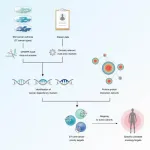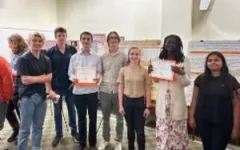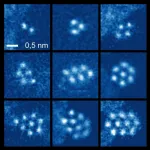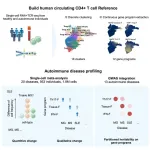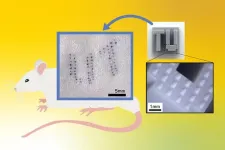A new, systematic analysis of cancer cells identifies 370 candidate priority drug targets across 27 cancer types, including breast, lung and ovarian cancers.
By looking at multiple layers of functional and genomic information, researchers were able to create an unbiased, panoramic view of what enables cancer cells to grow and survive. They identify new opportunities for cancer therapies in a significant leap towards a new generation of smarter, more effective cancer treatments.
In the most comprehensive study of its kind, researchers from the Wellcome Sanger Institute, Open Targets and their collaborators, pooled together data from 930 cancer cell lines. They then used machine learning methods to find the drug targets that show the most promise for developing new treatments, and the patients who would most benefit from such treatments. This involved assessing the occurrence of these targets in actual patient tumours and linking them to specific biological markers and genetic and molecular features found in the tumours.
The findings, published today (11 January) in Cancer Cell, not only bring researchers one step closer to producing a full Cancer Dependency Map1 of every vulnerability in every type of cancer, but help guide focused efforts to accelerate the development of targeted cancer treatments.
There are many types of cancer that currently lack effective treatments, such as liver and ovarian cancers. Chemotherapy and radiotherapy are effective treatments, but unable to distinguish normal cells from cancerous ones, so can cause damage throughout the entire body with harsh side effects, such as extreme fatigue, nausea and hair loss.
New precision drugs based on the exact genetic mutations that drive the cancer are needed to help the millions of patients diagnosed with some form of cancer each year, responsible for one in six deaths worldwide2. However, drug development has a 90 per cent failure rate3, making it both costly and inefficient.
With over 20,000 potential anti-cancer targets in the genome, determining which are suitable to target for specific types of cancers and patients is a significant challenge.
In this new study, researchers from the Wellcome Sanger Institute and their collaborators set out to narrow down potential drug targets. By analysing data available from the Cancer Dependency Map project, which involved CRISPR technology4 to disrupt every gene inside 930 human cancer lines one at a time, they were able to produce the most comprehensive view of potential new cancer targets to date.
The researchers first identified weaknesses within different cancer types – so-called genetic dependencies, meaning which genes, proteins or cellular processes that cancer cells rely on to survive – that could be harnessed to make new therapies. They then linked those weaknesses to clinical markers to identify patients in which those therapies would be most effective. Finally, they explored how dependency-marker pairs fit into known networks of molecular interactions within cells, providing clues as to how cell biology is disrupted by cancer, and which targets might yield the most effective therapies.
The work provides a clearer understanding of which types of cancer can possibly be treated by existing drug discovery strategies and pinpoint areas where novel and innovative approaches are needed.
The findings underscore the importance of tailoring treatments to the unique characteristics of each cancer, promising more personalised care for patients with fewer side effects in the future.
Dr Francesco Iorio, co-lead author of the study from the Computational Biology Research Centre of Human Technopole, said: “Analysing the largest-ever cancer dependency dataset, we present the most comprehensive map yet of human cancers' vulnerabilities - their "Achilles heel". We identify a new list of top-priority targets for potential treatments, along with clues about which patients might benefit the most - all made possible through the design and use of innovative computational and machine intelligence methodologies.”
Dr Mathew Garnett, co-lead author of the study at the Wellcome Sanger Institute and Open Targets, said: “Our work uncovers 370 candidate priority targets for tackling the most prevalent cancers, including breast, lung and colon cancers. This work exploits the latest in genomics and computational biology to understand how we can best target cancer cells. This will help drug developers focus their efforts on the highest value targets to bring new medicines to patients more quickly.”
Dr Marianne Baker, science engagement manager at Cancer Research UK, said: “Two people might have the same type of cancer, but their diseases can behave differently. That is why we need precision medicine. This ambitious work is a compelling example of research informing drug discovery from the start, paving the way for more effective precision cancer therapies. Giving people treatments for their unique cancer can improve the odds of success and help more people affected by cancer live longer, better lives.”
ENDS
Contact details:
Jelena Pupavac
Press Office
Wellcome Sanger Institute
Cambridge, CB10 1SA
Email: press.office@sanger.ac.uk
Notes to Editors:
1. The Cancer Dependency Map is an international collaboration between the Wellcome Sanger Institute and the Broad Institute in the United States. The results of the first iteration of the Cancer Dependency Map were published in 2019. The Cancer Dependency Map at the Sanger Institute is a project that aims to assign a dependency to every cancer cell in a patient, which could be exploited to develop new therapies. It is linked with the Open Targets initiative to facilitate new drug target identification. Projects developed by the Open Targets consortium have supported elements of the Cancer Dependency map to facilitate new drug target identification inclusive of this research. https://depmap.sanger.ac.uk/
2. https://www.cancerresearchuk.org/health-professional/cancer-statistics/worldwide-cancer
3. https://www.ncbi.nlm.nih.gov/pmc/articles/PMC9293739/
4. CRISPR-CAS9 is a tool used to precisely edit DNA.
These data can be accessed on the Sanger Institute’s Cancer Dependency Map website: https://depmap.sanger.ac.uk/
Publication:
C. Pacini et al. (2023) ‘A comprehensive clinically informed map of dependencies in cancer cells and framework for target prioritization’ Cancer Cell. DOI: 10.1016/j.ccell.2023.12.016
Funding:
This research was supported by Wellcome and Open Targets. For full funding acknowledgements, please refer to the publication.
Selected websites:
Human Technopole
Human Technopole is an Italian life science institute situated at the heart of MIND (Milano Innovation District). Its overarching mission is to enhance human health and well-being by conducting cutting-edge research in the life sciences, with a focus on developing innovative approaches in preventive and personalized medicine. Additionally, the institute is dedicated to establishing and operating scientific services and facilities that are accessible to external researchers. It plays a crucial role in training the next generation of leading scientists, as well as promoting innovation and progress through technology transfer. Find more at https://humantechnopole.it
Open Targets
Open Targets is a pioneering public-private collaboration that aims to transform drug discovery by systematically improving the identification and prioritisation of drug targets and improving the success rate for developing new medicines. The consortium is a unique, pre-competitive partnership between companies and not-for-profit research institutes. The partners are GSK, Biogen, Takeda, Celgene, Sanofi, the Wellcome Sanger Institute and the EMBL’s European Bioinformatics Institute (EMBL-EBI). Open Targets combines the skills, knowledge and technologies of its partner organisations, offering a critical mass of expertise that does not exist in any single institution. Large-scale genomic experiments (Sanger Institute) and computational techniques (EMBL-EBI) developed in the public domain are blended with formal pharmaceutical R&D approaches to identify causal links between targets, pathways and diseases. This enables the partners to systematically identify drug targets, and prioritise them for further exploration. Find more at https://www.opentargets.org/
The Wellcome Sanger Institute
The Wellcome Sanger Institute is a world leader in genomics research. We apply and explore genomic technologies at scale to advance understanding of biology and improve health. Making discoveries not easily made elsewhere, our research delivers insights across health, disease, evolution and pathogen biology. We are open and collaborative; our data, results, tools, technologies and training are freely shared across the globe to advance science.
Funded by Wellcome, we have the freedom to think long-term and push the boundaries of genomics. We take on the challenges of applying our research to the real world, where we aim to bring benefit to people and society.
Find out more at www.sanger.ac.uk or follow us on Twitter, Instagram, Facebook, LinkedIn and on our Blog.
About Wellcome
Wellcome supports science to solve the urgent health challenges facing everyone. We support discovery research into life, health and wellbeing, and we’re taking on three worldwide health challenges: mental health, infectious disease and climate and health. https://wellcome.org/
END
